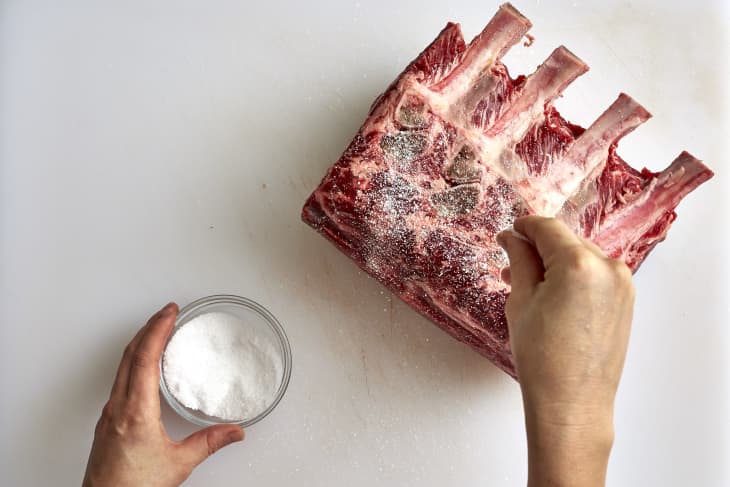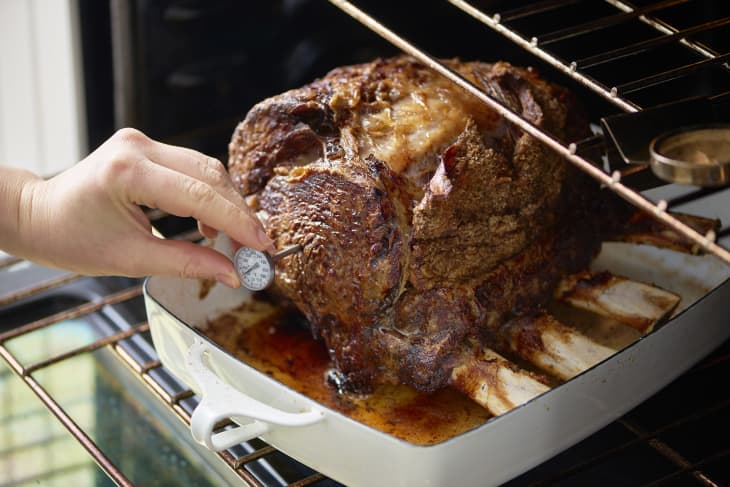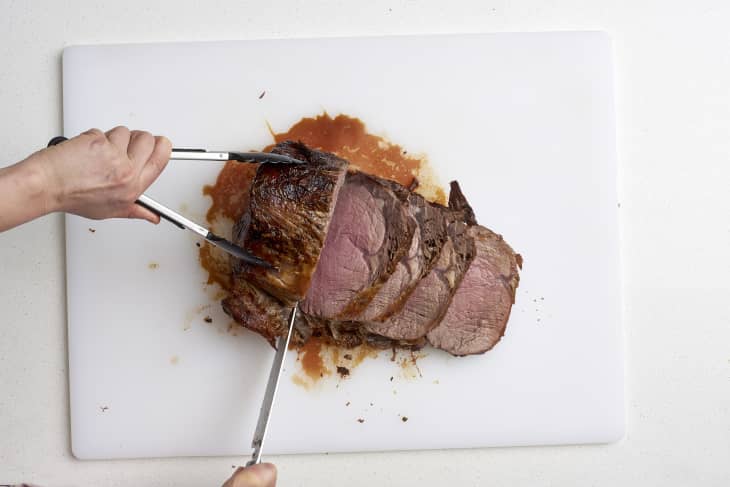How to Make Simple and Easy Classic Prime Rib
 |
| (Image credit: Joe Lingeman) |
The benefits of prime rib roast cannot be overstated. Standing tall and prepared for carving on a serving tray, its black, crisp exterior teases a soft, pink inside bursting with a powerful beef taste. You may create a traditional holiday feast by serving this special occasion cut of beef with fine wine, a dollop of handmade horseradish cream, and a tray of golden roasted potatoes.
You'll want some confidence that your efforts will be rewarded if you're spending time and money on a prime rib roast at home. This straightforward promise of excellence in all that this straightforward, uncomplicated method is.
The Ideal Method for Cooking Prime Rib Is Oven Searing
The risk of overcooking is significantly decreased when cooking a rib roast in the oven.
The roast is started in a very hot oven, and the temperature is gradually lowered throughout the roasting process to produce the mahogany-colored crust. If it sounds familiar, it's because we employ the same technique while making our go-to roast turkey dish.
Important Guidelines for Cooking Prime Rib
Remove the roast's chill. At least two hours before you intend to cook the roast, take it out of the refrigerator. Not long enough for the raw roast to reach the temperature/time danger zone, so don't be alarmed. This only helps the roast cook a little bit more quickly in the oven by removing the cold.
Prime rib should be seasoned early. As soon as you take the rib roast out of the fridge, season it. This seasoning will absorb some moisture from the surface, enhancing the oven sear.
Roast for 15 minutes at 500 degrees Fahrenheit. Roast the prepared roast for 15 minutes in a hot oven. Be ready: There will be smoke and a considerable bit of fat released from the roast during this time. Open a couple windows and turn on the vent hood for your oven. Don't worry; the smoke will have left your kitchen long before dinner guests show up there.
Cook to the desired doneness by reducing the heat. Cook for 13 minutes per pound at 325°F after lowering the oven's temperature. Before you start checking the roast's temperature, let it cook for at least another hour. Larger roasts can take up to 2 hours in total. For rare and medium, respectively, cook the prime rib at 115°F and 120°F, and 130°F. Keep in mind that the roast will continue to cook as it rests.
What Exactly Is a Prime Rib Roast?
The 6th to 12th ribs of a beef cow's rib primal are referred to as prime rib roast, also known as standing rib roast. There is significant debate over whether prime rib can only be referred to as "prime" if it has received a grade of "prime," "choice," or "select" according to the USDA grading criteria.
In this context, the term "prime rib roast" refers solely to this cut, not to the grading. Although you may spend a lot of money on a prime rib roast just for pleasure,
Is Ribeye the Same as Prime Rib?
A prime rib consists of six ribs, whereas ribeye steaks are sliced from the prime rib. There is a range in weight from 12 to 16 pounds.
 |
| (Image credit: Joe Lingeman) |
Should I buy a Bone-In or Boneless Prime Rib?
Prime rib can be purchased with or without the bone, and the cost per pound varies greatly depending on the preparation. Inform your butcher how many people you'll be feeding and your desired budget. A pound of bone-in meat per person, or one bone for every two diners, is the standard recommendation.
Additionally, you can request that your roast be prepared with "the ribs cut away and roped back" from the meat. The roast is now simpler to prepare and carve. Instead of a roasting rack, the butcher will secure the ribs under the roast, trim some fat, and tie the roast for you.
 |
| (Image credit: Joe Lingeman) |
The Finest Prime Rib Sauces
There are a number of different ways to serve a sauce with a prime rib roast, but you should definitely choose one of these three options:
- My personal favorite meal is horseradish cream since it can be prepared the day before and because I enjoy the contrast between the fatty meat and the refreshing, peppery cream.
- While the roast is resting, you may make gravy out of the pan drippings by thickening them with a mixture of flour and butter.
- The same pan drippings are used to make au jus, which is lighter than gravy.
 |
| (Image credit: Joe Lingeman) |
Resting Prime Rib after Cooking will Make it Juicier
The juiciness of prime rib is only enhanced by a long rest after roasting. For me, this is the ideal opportunity to greet visitors and serve them a cocktail so that you may bring the entire roast to the table for carving.
Carving is as simple as removing the string and slicing the roast if the roast has been cut and the bones have been tied below. This is the perfect time to use your electric carving knife for a bone-in rib roast.
Here's how to purchase, cook, and roast prime rib, the most well-known beef roast.
- YIELD: Serves 6 - 8
- PREP TIME: 15 minutes
- COOK TIME: 2 hours - 2 hours 30 minutes
INGREDIENTS
1 (7-pound) prime standing rib roast (3 to 4 bones, see Recipe Note)
1 tablespoon kosher salt (you might not need all of this)
For the horseradish cream sauce:
1 cup heavy cream
1 cup sour cream
1/4 cup prepared horseradish
1 teaspoon freshly ground black pepper
1/2 teaspoon kosher salt
1/4 teaspoon cayenne pepper (optional)
EQUIPMENT
Roasting pan or 9x13-inch metal pan
Probe thermometer
Chef's knife and cutting board
INSTRUCTIONS
- Two hours prior to cooking, take the roast out of the fridge and salt it. Use paper towels to pat the roast dry before liberally salting it, being careful to cover the sides, ends, and ribs below. You don't need to use all the salt. With the ribs in the pan and the fat cap up, place the roast in a roasting pan or 9 x 13-inch metal baking pan. Leave for roughly two hours at room temperature.
- Construct the horseradish sauce (optional). In a medium bowl, combine all the ingredients and whisk to combine. Refrigerate with a cover until ready to serve.
- The oven temperature is set at 500 °F. Set a rack in the center of the oven and heat it to 500 degrees.
- Roast for 15 minutes in the oven. 15 minutes in the oven with the roast. Be ready; there will be smoke and a considerable quantity of fat being released from the roast during this time. Open a couple windows and turn on the vent in your oven or stove. Don't worry; once the roast has finished smoking, your kitchen will be smoke-free long before dinner guests arrive.
- Cook for 13 minutes per pound at 325°F after lowering the oven's temperature. Reduce the oven's heat to 325°F and cook the roast for at least a further hour before checking its temperature. Larger roasts can take up to 2 hours in total. 115°F for rare and 120°F to 130°F for medium-rare; keep in mind that the roast will continue to cook while it rests.
- Prior to cutting, let the roast rest. Remove the roast from the oven and place it on a clean cutting board for carving when it reaches the temperature you choose. Rest for 30 minutes while covered in aluminum foil.
- Slicing the roast. Cut the string free with a pair of shears or a knife. Slice the prime rib roast into 1/2-inch-thick pieces after removing it from the bones. Serve with lots of gravy or horseradish cream.
Recipe By: Thekitchn.com
SEE: Better Than KFC: Impossibly Crispy Baked Chicken Nuggets
Post a Comment